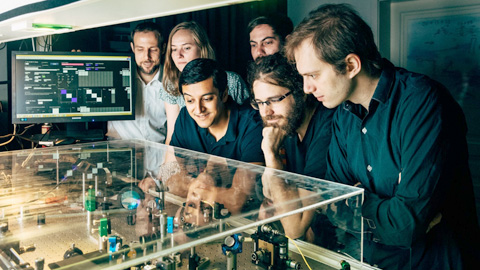New efficient and robust quantum entanglement measurement method developed

17/07/2018
The dream of completely secure communication is moving ever closer to realisation, thanks to the entanglement between quantum systems. A key generated through this quantum mechanical phenomenon cannot be cracked without breaking the laws of physics themselves. In recent years, using high-dimensional entanglement has made it possible to encode ever larger amounts of information per photon, one single particle of light. Through the entanglement of several dimensions it is possible to quantum correlate this information between two (or more) photons. Nonetheless, several challenges are yet to be overcome to make this approach practically viable. One of these is the development of efficient measurement techniques for the certification of high-dimensional entanglement.
A viable work-around has now been found by the group of former UAB postdoctoral researcher Marcus Huber at the Austrian Academy of Sciences (ÖAW), and in which UAB Department of Physics researcher Paul Erker also participated, through the development of a new method for the certification of high-dimensional entanglement. They successfully implemented it in a cutting-edge experiment which they report in their publication in Nature Physics.
Initially, the authors investigated the problem from a mathematical perspective, and drastically reduced the number of required measurements to verify high-dimensional entanglement. While most conventional measurements of quantum systems result in individual yes or no answers, there are also measurements with many more possible answers. But even these require asking more and more questions with increasing system dimension. The researchers identified a mathematical property of two particular measurement settings with multiple answers that enables the unambiguous verification of high-dimensional entanglement. “Using just two questions, we were able to answer almost everything one could ask about the quantum state,” illustrates group leader Marcus Huber.
For the experimental demonstration of their new concept, the team used photons whose orbital angular momentum (a measurable property related to the rotation of photons) can carry entanglement in high dimensions. These photons were measured using the newly developed techniques and the collected data indeed confirmed the high-dimensional entanglement. In fact, researchers achieved a 9 dimension entanglement never before seen in such an experiment. “While similar experiments have previously used hundreds if not thousands of measurement settings to arrive at comparable conclusions, we needed only two,” says Jessica Bavaresco, first author of the study.
The advantage of the new measurement method is not just the drastic increase in efficiency. It also features improved robustness to environmental noise - which can ruin these types of experiments - and is more secure than previous methods. Overall, the scientists are convinced that the new measurement technique opens up a number of interesting applications and will greatly simplify future research in cryptography and in high-dimensional quantum communication.
Paul Erker is a predoctoral researcher at the Group of Quantum Information and Phenomena at the UAB Department of Physics, under the supervision of ICREA researcher Andreas Winter. The research, directed by Marcus Huber from the Institute of Quantum Optics and Quantum Information (IQOQI), Austrian Academy of Sciences (ÖAW), included the participation of researchers from Austria, Czech Republic, France, Spain, Switzerland and the United Kingdom.
Original article:
Jessica Bavaresco, Natalia Herrera Valencia, Claude Klöckl, Matej Pivoluska, Paul Erker, Nicolai Friis, Mehul Malik and Marcus Huber. Measurements in two bases are sufficient for certifying high-dimensional entanglement. Nature Physics. http://dx.doi.org/10.1038/s41567-018-0203-z